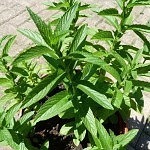Those Who Cannot Remember the Past are Condemned to Repeat It
Humanity has been inventing new technologies since before recorded time; however, not all technologies have proven beneficial. Over the years, there have been many breakthroughs in science, breakthroughs that have also come with unexpected consequences.
DDT
Dichloro-diphenyl-trichloroethane or DDT was first synthesized in 1874, but it wasn’t until 1940 that it came to be used as a pesticide. Paul Muller is the chemist who discovered that DDT was a highly effective insecticide that killed a wide range of insects, including those that spread malaria, plague, thyphus and other diseases. It was inexpensive, persisted in the environment (meaning reapplications were infrequently needed), it was devastating to insect populations, it increased crop yields, and saved lives. It was estimated that in 20 years of use it saved 500 million lives that would have been lost to malaria alone. DDT became a global phenomenon and Muller was awarded the Nobel Prize.
Because of its widespread use, the harmful effects of DDT became impossible to ignore. Although warnings about DDT’s harmful effects came from scientists as early as the 1940s, it wasn’t until Rachel Carson’s book, Silent Spring, published in the 1960s that the public became concerned about its environmental impact.
DDT works by interfering with the nervous system. Girls exposed to DDT before puberty are five times more likely to develop breast cancer later in life. Workers accidentally exposed to DDT have reported prickling sensations in the mouth, nausea, dizziness, confusion, headache, lethargy, poor coordination, fatigue, vomiting, and uncontrollable tremors. As toxic as DDT is to humans, it is far more devastating to wildlife. It became clear that DDT bio accumulates in the bodies of animals and people, and if it were to be continued to be used in the U.S., many species of birds were headed for extinction, including the bald eagle, America’s national emblem. One of the first acts of the Environmental Protection Agency was to ban the use of DDT in the U.S.
Lead and Leaded Additives
Lead is a malleable, corrosion resistant, inexpensive, and easily obtainable dull colored silver-grey metal. Lead is usually extracted from the mineral galena. Lead has been in use since the days of the Roman Empire. Before we began using it, most of the lead was safely tucked away beneath the Earth’s surface, but industrial activities have resulted in drastic increases in the levels of lead that are found in the environment.
Lead has been used in paint, piping, pewter, pottery, insecticides, hair dyes, and as an anti-knocking additive in gasoline. Lead is still used widely in plumbing, and many cities in the U.S. still have 100% lead pipes. Lead is used in ammunition, batteries, cosmetics, pigments, cable sheathing, weights (for lifting), weight belts for diving, some types of glass, and in materials used to protect against radiation. Lead is also used to store corrosive liquids.
Lead is harmful to nearly all forms of life. It is toxic, teratogenic (disrupts the development of an embryo or fetus), and carcinogenic. Very harmful amounts of lead can still be odorless, tasteless, and invisible. Even small amounts of lead can cause a reduction in IQ, and an increased risk of stroke, heart attack, headaches, nausea, abdominal pain, insomnia, fatigue, and many other health conditions. Most scientists agree there is no such thing as a safe level of lead in the human body.
CFCs
Chlorofluorocarbons, better known as CFCs, were once thought of as a scientific miracle. CFCs are nontoxic (previously utilized refrigerants were very toxic) and nonflammable chemicals comprised of carbon, chlorine, and fluorine. CFCs were widely used as refrigerants for freezers, refrigerators, and air conditioners. They were also used in fire extinguishers and aerosol sprays. At their peak, a million metric tons of CFCs were produced annually, with over a billion dollars in sales.
It took a while for the problem with CFCs to be discovered. They seemed to be perfectly safe, after all, CFCs remain stable and inert until they reach the upper atmosphere or stratosphere. Prof. Rowland and Dr. Molina showed that once UV radiation strikes CFCs, a series of chemical reactions begin. Chlorine is released from CFCs. These chlorine atoms destroy ozone in catalytic reactions. A single chlorine atom can have this effect for decades, destroying thousands upon thousands of ozone molecules.
CFCs have settled in high concentrations over over the South Pole. Their reactivity with ozone is dependent upon exposure to UV radiation, and of course, a high degree of exposure happens every spring and summer (September through February for the Southern hemisphere). This hole in the ozone layer is so large that it extends all the way over Antarctica and southern South America. This affects thousands of people. Antarctica has a research-based community, which varies from 1,000-4,000 inhabitants. The South American cities of Ushaia (pop. 60,000), Punta Arenas (pop. 123,000), and Rio Gallegos (pop. 98,000), and the Falkland Islands are all regularly affected by the reoccurring hole in the ozone layer. At times, the hole widens affecting northern population areas including Rio Gallegos, Puerto Santa Cruz, and Rio Grande which affects an additional 200,000 people. Safely going outside in these areas during times of decreased ozone means wearing extensive protective clothing and goggles, or risking skin cancer, cataracts and damaged DNA. Most inhabitants opt for the extensive protective gear.
PCBs
Polychlorinated biphenyls or PCBs are a group of man-made chlorinated organic compounds. They are oily liquids or solids with colors ranging from clear to yellow. PCBs had a number of industrial applications and they were widely used in electrical equipment and as lubricants. Invented by the Swann Chemical Company in 1929, their manufacture was quickly taken over by Monsanto, after Monsanto bought Swann Chemical Company in 1933. Then Monsanto became the sole manufacturer of PCBs until the EPA banned their manufacture in 1979.
PCBs can cause skin lesions that can last years, and it is a probable carcinogen. PCBs can damage the liver, immune system function, and endocrine systems. Internal documents show that Monsanto knew about these harmful effects for decades, but instead of discontinuing their manufacture, Monsanto hired scientists to conduct fraudulent studies. Monsanto doesn’t deny that PCBs have contaminated everyone and everything in the entire planet. Instead they argue that since PCBs are everywhere, there’s nothing to worry about.
Asbestos
Asbestos refers to a group of six naturally occurring silicate minerals: actinolite, amosite, anthophyllite, chrysotile, crocidolite, and tremolite. Asbestos is made up of thin fibrous crystals, and these fibers are composed of millions of microscopic fibrils. Asbestos was once in high demand in the Western world due to its remarkable characteristics: Asbestos is an excellent insulator. It doesn’t conduct electricity. It is highly fire resistant. It absorbs sound, is phenomenally durable, flexible, and inexpensive to produce. Asbestos was used in a wide variety of applications from shipbuilding to construction, plastics, textiles, cigarette filters, and many other uses. Despite its known health risks, asbestos is still in high demand in Asia and Africa. Asbestos is banned in 50 countries worldwide, but not in the U.S. and Canada, though both countries now restrict its use. More than two million metric tons of asbestos is produced annually.
Studies have linked more than a dozen different diseases to asbestos exposure including asbestosis and many different types of cancer, especially lung cancer, mesothelioma, and asbestos-related pleural effusions. According to the World Health Organization, asbestos is still responsible for an estimated 43,000 deaths annually.
Flame-Retardants
According to the U.S. Fire Administration, more than 3,000 Americans died from fires in 2011. There have been many different efforts over the years to reduce the number of deaths by fire in the U.S. Not all of them have been successful.
Substances treated with flame-retardants ignite more slowly than untreated substances, but the difference is minimal. And when these treated substances burn, they produce twice as much smoke, six times as much carbon monoxide, and ninety times more soot. People rarely burn to death in fires. The smoke, soot, and carbon monoxide usually kill them.
The flame retardant chemicals used in furniture, electronics, and textiles are remarkably similar to many pesticides that are used. As a matter of fact, some pesticides and flame-retardants are the exact same chemical. Not all flame-retardants present a serious health risk, but organohalogen and organophosphorous flame-retardants do. DDT is a organohalogen, and like DDT, these chemicals persist in the environment and bio accumulate in the food chain. Flame-retardants have been found in polar bears in the North Pole and in Tasmanian devils in the South Pole. They have been found in animals all over the world. These chemicals have contaminated the entire planet. Unfortunately, they can cause a number of health problems including: cancer, endocrine disruption, hypothyroidism, hyperactivity, reduced IQ, and other neurological impairments. These chemicals are also reproductive toxins in both males and females. Furniture made with these chemicals contains 5% flame-retardants, by weight. Unfortunately they are not bound to treated substances. They off gas as dust in your home and are then ingested through hand to mouth contact. Children and pets are fond to have higher levels of these chemicals in their bodies than adults.
Conclusion
No technology is above reproach. When criticizing technologies new and old, counter arguments are often shrouded in attacks on the individual instead of the critique. All too often we hear accusations like “you’re anti-science!” even when it is the scientific method that has shown these technologies to be flawed. As our technology progresses, so must our understanding of technology. Not all technological advancement is progress. In fact, some technologies cause far more problems than they solve.
Related Products:
Recommended Reading:
Sources:



